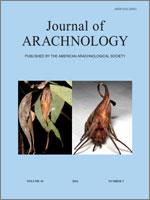A major advantage of having behavior controlled by a circadian clock is that the organism may be able to anticipate, rather than respond to, important daily events in its environment. Here, we describe the behavioral rhythms of locomotor activity and web building in the orb-weaving spider Cyclosa turbinata (Walckenaer, 1841). Web building occurs late in the scotophase, in absolute darkness, and is initiated and completed before lights-on under light:dark cycles in the laboratory. This scheduling presumably enables web-building to occur under the cover of darkness, thereby avoiding visual predators. Locomotor activity occurs predominantly in the dark with a sharp peak within one hour after lights-off and a broader peak occurring before lights-on. The locomotor activity rhythm free runs under constant dark and constant temperature conditions, thus indicating endogenous circadian control. Evidence from the free running rhythm suggests that the first peak under light:dark cycles is a result of masking but that the second peak is attributable to the endogenous circadian oscillator. The period of the free run is exceptionally short, about 19 hours. In comparison with locomotor activity, web building is quite sporadic under constant dark conditions, making detection of periodicities difficult and, therefore, whether web-building is under endogenous circadian control or is driven by exogenous factors remains unresolved.
How to translate text using browser tools
1 November 2016
Exceptionally short-period circadian clock in Cyclosa turbinata: regulation of locomotor and web-building behavior in an orb-weaving spider
Darrell Moore,
J. Colton Watts,
Ashley Herrig,
Thomas C. Jones
ACCESS THE FULL ARTICLE

The Journal of Arachnology
Vol. 44 • No. 3
November 2016
Vol. 44 • No. 3
November 2016
Adaptation
Behavioral rhythm
chronoecology
locomotor activity




